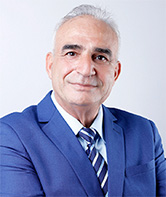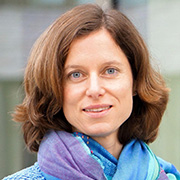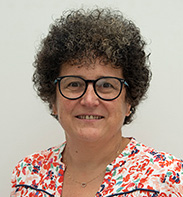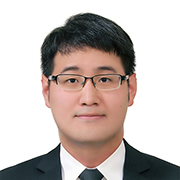Plenary & Keynote Lectures 2026

Plenary – Cake-Forming Filtration of Suspensions – Challenges and Solutions
Prof. Dr.-Ing. Habil. Ioannis Nicolaou
Owner and Director of the Company NIKIFOS – Cyprus
30. June 2026 – Room 1
The cake-forming filtration of suspensions, which includes the optional steps of washing and deliquoring of the filter cake, is a key method in solid-liquid separation. It is found in a wide range of industries where diverse continuous and batch filter apparatuses are used. Such fields include the chemical, petrochemical, food and beverages, pharmaceutical, pulp and paper, electronics, metallurgical, waste water industries just to name some. It is common for all filter apparatuses to have a filter area covered by a filter medium and the formation of a filter cake. The driving potential for the cake formation can be a gas pressure difference: vacuum (continuous vacuum belt, drum, disc and pan filters) or overpressure (continuous pressure drum and disc filters, pressure nutsche filters), a hydraulic overpressure (candle and pressure leaf filters, filter presses, filter press automats) or a centrifugal pressure (all types of batch and continuous filter centrifuges).
Depending on the suspension characteristics as well as the process requirements and plant specific restrictions, the selection of the proper filter apparatus and the determination of its optimal operational settings with minimal and systematic experimental effort is a real challenge for new projects. On the other hand, for running filter apparatuses, it is extremely important to troubleshoot and reliably determine the optimization potential as well as the quantification of the possible performance improvement by considering the use of another filter. Solutions for the aforementioned challenging tasks will be presented.
Simple, praxis friendly and half-empirical mathematical models for formation, washing and deliquoring (including squeezing) of the filter cake will be presented. Emphasis will be given to the model specific dimensionless kinetic parameters as well as to the model adaptation parameters, which are called the efficiency parameters. The efficiency parameters have a physical meaning and characterize mainly the cake structure for the given suspension and, strictly speaking for the given apparatus. How the use of the efficiency parameters enables the determination of scale -up factors for the main filter performance parameters (solids mass rate, cake moisture content and optionally the wash out content of the discharged cake) will be discussed. Furthermore, it will be explained, how the judgment of the performance of a given filter as well as the comparison of its performance with other filters can be done correctly by using the efficiency parameters and the kinetic parameters for each step. Finally, the importance of establishing a suspension typology and a common language among the filtration specialists in different companies and institutions will be emphasized.Prof. Dr. Ioannis Nicolaou is currently the president of NIKIFOS, a chemical engineering company founded in 2000 in Cyprus. With 40 years of experience, he specializes in solid-liquid separation, combining extensive research with practical expertise. For the past 25 years, he has provided professional support worldwide to numerous filter users, as well as filter and centrifuge manufacturers, helping them apply practice-oriented theory to solve their projects reliably and with minimal experimental effort. This leads to significant time and cost savings, a deeper understanding of their projects, and the establishment of a shared language. His support includes licensing user-friendly software, offering consultancy, and conducting training sessions (both online and on-site).
Born in Cyprus, Prof. Dr. Nicolaou studied chemical engineering at the University of Karlsruhe (now KIT) in Germany as a DAAD scholar. He graduated with distinction (first class) in 1984 and was honored with the Emil Kirschbaum Award in 1985 for his outstanding diploma thesis. From 1986 to 1996, he worked at the Institute of Mechanical Process Engineering and Mechanics, collaborating with Prof. Stahl, a global leader in applied solid-liquid separation research. In 1991, he earned his Ph.D., graduating with distinction (first class), and in 1996, he completed his professorial thesis (Habilitation) in mechanical process engineering, receiving a teaching authorization in the field. For his exceptional research in filtration, he was awarded the Heinz-Maier-Leibnitz Award by the German government in 1994.
From 1997 to 2000, he served as the Head of the Solid-Liquid Separation and Crystallization team at Axiva (formerly Hoechst AG). Since 1997, he has been a professor at the University of Karlsruhe (KIT), delivering his own lectures. In 2002, he was a visiting professor at the University of Florida’s Engineering Research Center for Particle Science & Technology, where he was recognized as an eminent scholar. Since 2000, he has owned NIKIFOS, focusing on the development and licensing of practice-oriented and user-friendly software for cake-forming filtration of suspensions (FILOS, CENTRISTAR, FILASTRA), as well as for hydrocyclones (CYCLONPLUS). In addition to software development and professional support for program users, he offers online training in solid-liquid separation and consultancy services.

Keynote – How can we bridge the gap between indoor air quality and energy efficiency?
Prof. Dr. Jennifer Niessner
Heilbronn University of Applied Sciences / Heilbronn – Germany
date tba – Room 1
We spend most of our time in indoor environments. Thus, indoor air quality is of paramount importance for our health and well-being. Ventilation and air purification are essential for maintaining good indoor air quality, addressing a wide range of contaminant sources such as wood treatment in furniture, building materials, cleaning agents, indoor combustion processes but also the occupants. While the energy crisis is increasing challenges with respect to energy efficiency window ventilation, stationary ventilation systems, and mobile air purifiers require energy for heating, cooling, and/or air circulation. To ensure a healthy and comfortable indoor environment with minimal energy consumption, advanced strategies are needed, which combine ventilation and air purification measures based on factors such as room occupancy, outdoor temperature, desired health levels, and other relevant parameters in a clever way.
In this talk, we will explore indoor contaminants and their sources, the various ventilation and air purification measures along with their energy demands, and their impact on thermal comfort. We will then present experimental as well as CFD modeling and simulation approaches to assess the effects of ventilation and air purification on indoor air quality and thermal comfort. Finally, we will propose a model that determines the optimal combination of ventilation and air purification measures to minimize energy consumption while meeting defined thresholds for indoor air quality and thermal comfort.
It will be shown that it is possible to provide a healthy and comfortable indoor environment while significantly reducing the energy input to do so. In the future, validated simulation data may be used to train AI algorithms, potentially enabling the automated prediction and optimization of energy-efficient operating parameters. This talk highlights the critical role of ventilation strategies to effectively and sustainably create healthy, comfortable indoor environments. At the same time these measures will significantly contribute to the reduction of the carbon footprint in the building sector.
Prof. Dr. J. Niessner is a research professor for fluid mechanics at Heilbronn University of Applied Sciences, member of the Promotionsverband BW and director of the Institute for Flow in Additively Manufactured Structures (ISAPS). She received her doctorate and habilitation in the field of modeling and simulation of multiphase flows in porous media and did research at the University of Stuttgart, the Institut National de Recherche en Informatique et Automatique, Rocquencourt, in France, the University of Bergen in Norway and Utrecht University in the Netherlands. Her research covers both numerical modeling and simulation as well as and experimental investigation of aerosol particle transport and filtration, coalescense filtration, transport and separation of fibrous particles from solids and topology optimization of filter structures as a basis for 3d printing. Niessner received several awards for her research, e.g. the SIAG / GS Junior Scientist Prize of the Society of Industrial and Applied Mathematics, the Science Prize for outstanding application-oriented research of the Thomas Gessmann Foundation or the Sigrid and Viktor Dulger Prize of the Heidelberg Academy of Sciences.

Keynote – PM removal from combustion fumes – How to tackle regulation, energy efficiency and decarbonation
Prof. Dr. Laurence Le Coq
IMT Atlantique Nantes / Nantes – France
date tba – Room 1
XX
Laurence Le Coq is full Professor in Environmental Engineering at IMT Atlantique (https://www.imt-atlantique.fr/en). She is Delegate director in charge of Research & Economic Development at Institut Mines Télécom (https://www.imt.fr/en/).
Her research activitiy is conducted at GEPEA laboratory (https://www.gepea.fr/). It deals with mass transfer and particle transport through porous media. The research topics are :
• AEROSOL : Transport, capture and resuspension at fluid/solid (porous) interface – application to air depollution, fumes treatment and gas separation for energy valorisation or environmental issues.
• GAZEOUS POLLUTANTS : Transfer w/w.o. reaction at fluid/solid (porous) interface – application to COV, PAH and inorganic compounds adsorption for air, fumes and syngas treatment.
• POUROUS MEDIA : Structural and physico-chemical characterisation in relation with mass transfer / flow through porous media – application to filter clogging and adsorption.
She has been in charge of several research responsabilities. From 2015 to 2019 she was consecutively Vice Dean for Research & Innovation at IMT Atlantique and Dean for Research at Mines Nantes. From 2008 to 2015, she was in charge of the Department Energy System & Environmental Engineering at Mines Nantes, as well as deputy director of the Doctoral School in Engineering Science. She was deputy director of GEPEA laboratory (CNRS joint research unit) from 2012 to 2020.
Regarding teaching responsabilities, she was in charge of the Research Pathway of the Engineering Diploma, Mines Nantes from 2015 to 2019. From 2006 to 2008 , she was in charge of the MSc Environnement specialty GPEA, Univ. Nantes ; as well as of the Environnement engineering pathway of the Engineer degree, Mines Nantes from 2002 to 2007.
After a PhD thesis defended in 1996 at INP Grenoble (https://www.univ-grenoble-alpes.fr/english/), she was a research and teaching assistant at Nantes University – Process engineering Lab, Flow and Transfer team from 1996 to 1998. From 1998 to 2008, she was assistant professor at Mines Nantes in the Department Energy System & Environmental Engineering. She is full professor since 2008 at IMT Atlantique (former Mines Nantes before 2017) after obtaining her research habilitation (HDR) in 2006.
Laurence Le Coq is Co-author of 92 articles or international conference papers and more than 130 communications in national or international conferences. She has (co-)supervised 22 PhD thesis and 15 post-doctoral fellows. She has been involved in 30 collaborative research programs at international (5), european (3) or national (22) levels, as well as more than 23 industrial bilateral collaborations.
Keynote – TBA
Prof. Dr.-Ing. Bernhard Hoffner
University of Mannheim / Mannheim – Germany
date tba – Room 1
TBA
TBA

Keynote – Insights into shear-enhanced dynamic filtration : Advancements and applications in solid–liquid separation
Prof. Su-En Wu
Chung Yuan Christian University – Taiwan
date tba – Room 1
Membrane technology has been widely adopted for filtration and separation applications to enhance production quality and operational efficiency over the last decade. In practical chemical and biochemical separation processes, multicomponent suspensions often lead to membrane fouling, which becomes the primary contributor to filtration resistance. Therefore, reducing membrane fouling and filtration resistance is crucial for improving filtration performance and ensuring cost-effective membrane processes. Shear-enhanced dynamic filtration presents a promising alternative to traditional cross-flow filtration by introducing additional mechanical forces that significantly reduce cake-fouling resistance. Although the power consumption for dynamic filtration supply may be higher than the others in solid–liquid separation processing, there is more beneficial for preventing fouling from attaching to the membrane surface.
This presentation will provide an overview of recent developments and applications of dynamic filtration. The effects of operational conditions on cake properties, cake fomation, filtration flux, and product rejection will be thoroughly discussed. The influences of structural parameters on hydrodynamics and filtration performance in rotating-disk dynamic filtration can be evaluated by computational fluid dynamics simulation. This approach plays a critical role in determining the cost-effectiveness and future development. The novel designs of disk geometries will be determined by its high filtration flux and flexible operation. Overall, this presentation will explore potential strategies for advancing dynamic filtration technologies and promoting sustainability in solid-liquid industrial applications.